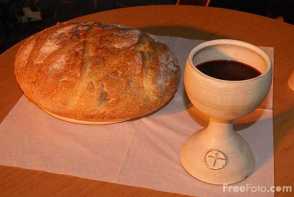(or, the dilemmas of Sunday Coffee Hour)
Recently I talked with a woman who’s in recovery from bulimia. “We’d never bring a bunch of recovering alcoholics into a room full of booze,” she said, “but you can’t really avoid food, and especially not at church.” Indeed, eating and drinking together is an important part of the community life in most churches, whether it’s limited to the celebration of communion (or Lord’s Supper, Mass, or Eucharist) or extended in “coffee hour” and potlucks. Eating together–as in MOST DAILY MEALS together–was an important part of the life of the early church. And it’s still important, though it’s different and in some ways, more complicated.
Some people really struggle with overeating, and I’ve heard from some folks, firsthand, that the platters of doughnuts and coffee cake and other goodies set out after church entice them in ways they don’t fully understand and want desperately to resist. (Before you’re tempted to cry out “they need willpower,” consider that the food industry does all it can to press the right ‘buttons’ to get us attracted and addicted to their offerings; if you don’t believe me, read this book.) Other people struggle with various forms of under-eating, and dread having to attend potlucks.
Eating in front of other people can be embarrassing, complicated, and messy in ways both literal and figurative. Maybe that’s partly because, despite all the rituals surrounding cooking, serving, and eating, eating is still so primal–such a naked acknowledgement of need. But I still think we’re meant to eat together. Eating together is good for what ails us–whether we’re inclined to binge, restrict, or whatever. A number of studies suggest that eating family meals protects children and teenagers emotionally, physically, psychologically, and socially. The most effective treatment for anorexia involves little more than love and meals eaten together. And people who eat with others are likely to be better nourished and at a healthier weight than those who eat alone.
So I think it’s important that churches eat together–especially when they eat together in ways that really focus on the togetherness. That’s not possible in all churches–say, in really big ones–but it’s more than possible in small churches and small groups. I do wonder if we’d not serve one another (and maybe even the Lord?) better if in these settings we’d be careful to meet the needs of those who are struggling with food issues in one way or another. I won’t say “no desserts!”–but I do wonder if communal meals (or snacks) that focus on simpler nourishment–like soup and bread, or fruit and cheese, or vegetable platters–would better serve the needs of those who (given the dismal statistics on these things) are likely to be struggling with food and weight.
At the same time, intentionally simpler and more mindful table fellowship can draw our attention to the meaning of the Lord’s Supper–which points us to Christ, our Bread of Life, and unites us to one another, Christ’s Body. “Don’t eat and drink without recognizing the body!” St. Paul wrote. Our food sustains us, as Christ sustains us–and as we sustain each other—the body of Christ. Eating is complicated, unduly alluring for some and unimaginably anxiety-producing for others. When you eat with others today–whether at church, at home, in a restaurant, or outdoors (lucky you!)–consider how you might build the body.





